61 Boring Birds: #61 Reed bunting & friends
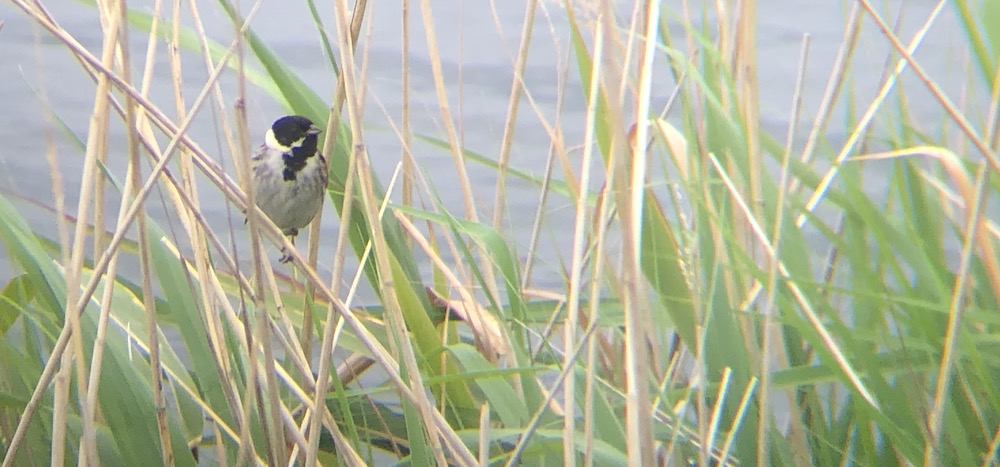
Well here we are at last. Not the end of the beginning. Not the beginning of the end. But the end of the end.
That’s the end.
Fitting, then, that this hottest of high summer days sees the slow gathering of storm clouds and the descent of a cooling breeze as I open the reservoir gates one last time. Two greylag geese stand the other side to welcome me. They wave tiny union jack flags on sticks.
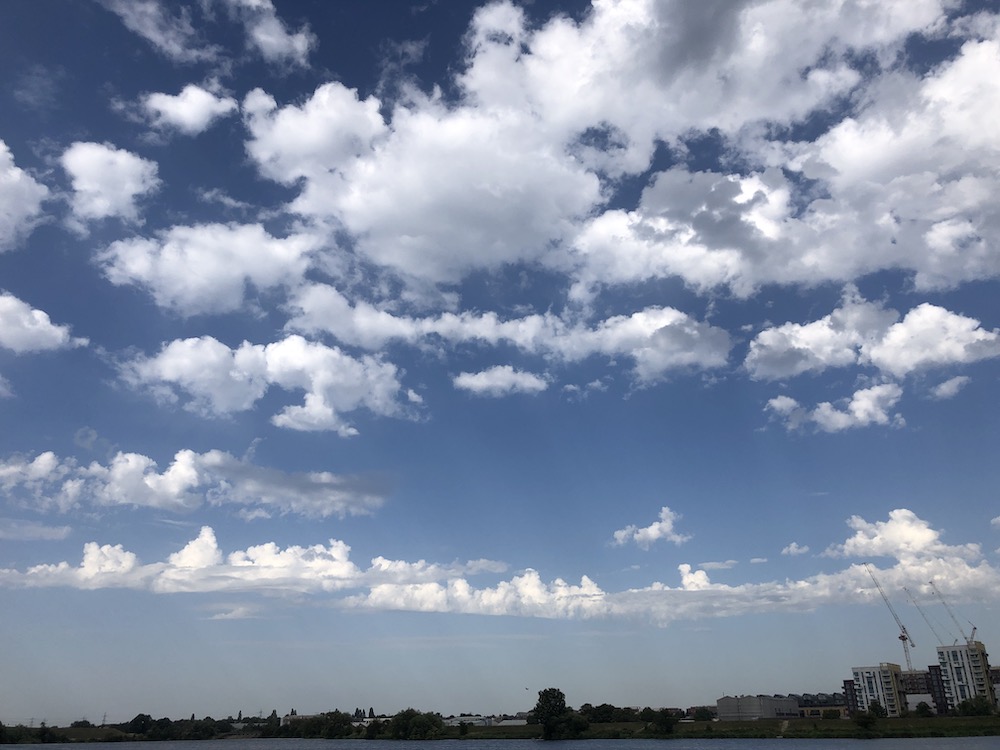
Coots and a large contingency of tufted ducks await me on Lockwood, with a few swans once more tending the flock. Down on High Maynard I watch two grebes exchange the gift of a fish. They’ve been active around their nest for some time, but are both off it and in the water today, so perhaps there are no eggs yet. Or the eggs have been taken.
The breeze stiffens considerably as I near the top end of the lake. Two common sandpipers fly up form the bank. The first, in a blind panic, lets the wind accelerate it up, away, and onwards up the overflow channel some twenty metres below, whie the other calmly turns into the wind and manoeuvres itself slowly and precisely, like a remote controlled drone, back to a feeding spot a little out of my reach. It looks so tiny and toylike against the massive, swollen mood of the heavy sky. Some egrets crouch nervously in the shade of a fallen log as a few spits of rain begin to fall.
And that’s as far as the drama goes. The cloud just playing, and it slowly turns off the wind faucet, and enters into a chaotic, colourful dance around the colour palette for the rest of the evening. Leaving me to concentrate on one final day of birds. Beginning with another failed attempt to find a yellow-legged gull (though being sure I didn’t find one is perhaps still a kind of success?)… and then on to the south side of the reserve.
I almost tread on a dunnock walking up the central path — “almost tread on” is something easy to say flippantly and not meant to be taken literally, but I really did almost squish the foolish little thing! Further along I come across a copule of juvenile robins, one of them sporting a little red on its breast. I wonder how many have bred here this year? I’ve been seeing birds in this mid-moult plummage for at least a month, and it can’t last all that long. I feel guilty for not featuring them on the blog in full as they are a disarming mix of cocky, cantankerous adult and naive youngster. Well, at least they’ve had a few good mentions.
At the south end of the path I stop by the bridge at the bottom corner of No. 3. The sun breaks through the clouds behind me and paints a lime green and purple ink scene withe the willows, the sky and its reflection. A tern in a hurry races towards me in slow motion, as if directed by Michael Bay, and, unlike in his films, makes the moment sublimely beautiful. On the centre of the lake the still growing shelducklings upend for food, a black-headed gull circles amiably, and a few freshly hatched black tufted ducklings decorate the scene with a last taste of spring. A moorhen submerges itself behind a lily pad to hide from me, but I see its red and yellow beak poking out among the duckweed.
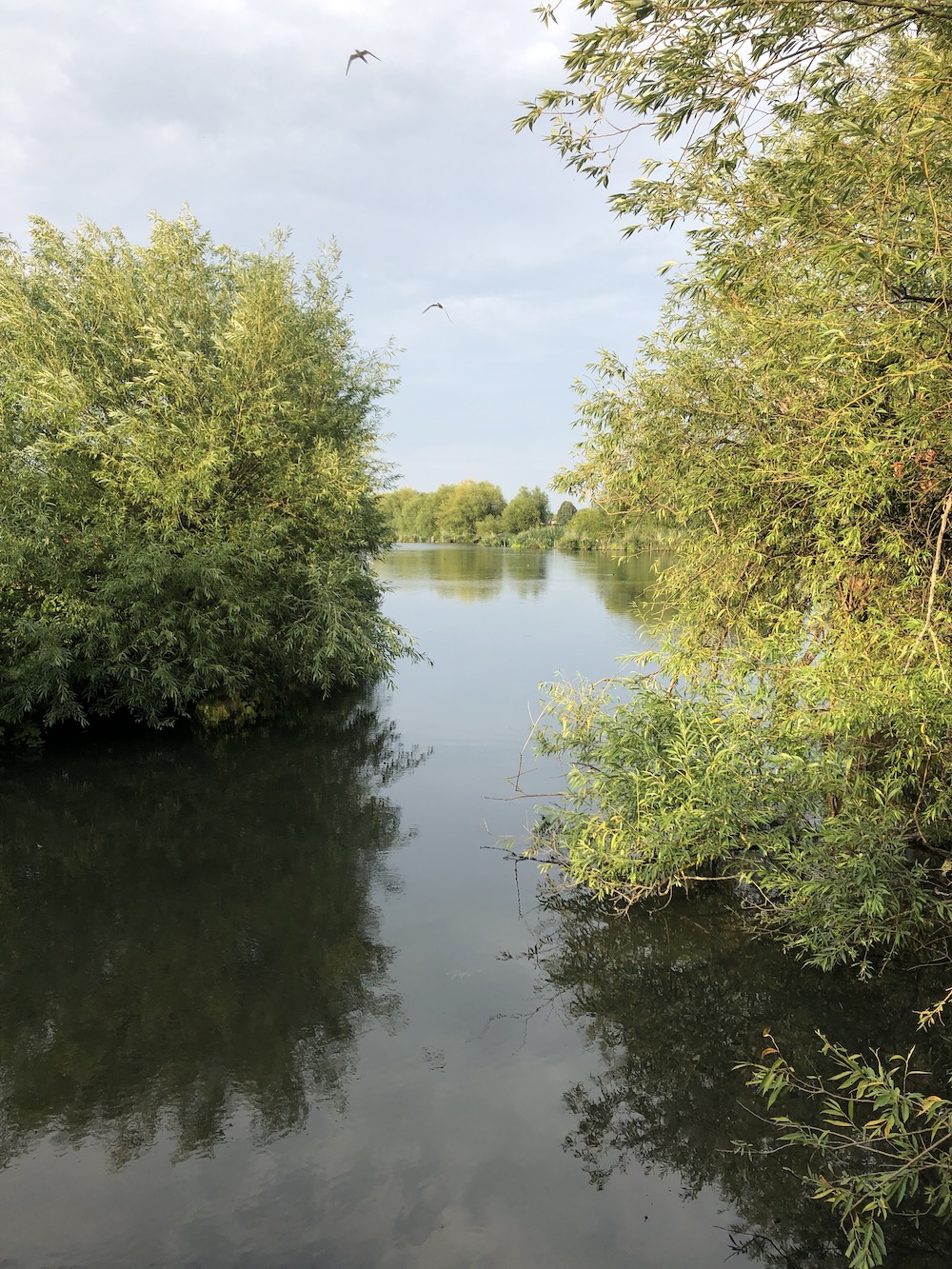
Rounding the corner I notice that there are ripe elderberries on a few of the bushes — at the beginning of the blog they would still have been in flower. As if to reenforce the message that there’s a new season in town, and its name is autumn, and summer better watch its back, I stumble into my first really significant warbler flock of the year. It’s likely that the group of at least fifteen chiffchaffs — mixed with various tits and a few blackcaps and chaffinches &mdsah; will have flown in together from somewhere further north. I can’t back this up, but migratory flocks’ behaviour generally seems freer than birds that spent the summer here, who have held territories, know the lie of the land, and have developed skulking habits suited to the local human and predator demographics.
Migratory flocks, by contrast, seem to leave all their self-preservatory inhibitions back at the ranch, and descend to bounce around like children in a ballpark. I was treated to some flybys of chiffchaffs about as close as my many joyous run-ins with swifts earlier this summer, and really got to examine their surprisingly long, forked tails and other details at close hand. I noticed a few of them had a warm, buffish tinge on their breasts too, slightly different to the duller, cool tones the local birds tend to display. Maybe this is a sign of a more avanced moult, rather than any great generic difference though.
No willow warbler among them &mdash had their been, it would be the subject of today’s blog — and I think to myself, “What if I don’t choose just one bird today? No one’s making me. No one puts Rhys in the corner. F**k you, I won’t do what you tell me. All for one and one for all. I am not a number. Liberte, egalite, farternite. I’m Spartacus.” What if today’s blog paints, in broad strokes, a picture of the birdlife of the reservoirs, as a final tribute to the variety that it contains. A tribute to all those there was no time to mention in the acceptance speech. A more fitting end I cannot imagine.
So I walk on to East Warwick, observing all with the fond eye of a holiday maker on their last evening in the tropical paradise. At the galvanised steel jetty the protective black-headed gull lifts up into the air once more and broadcasts a call which acts as a reprimand to me and a warning to its one remaining chick to float itself out into the open water behind the protective cordon of the coots’ aggression. It really is a survivor, but does not appear to be growing very quickly. I hope it makes it through this challenging childhood having taken strength from its experiences.
I’m dive-bombed by a herring gull that seems motivated more by guarding its perch than out of concern for any youngsters’ wellbeing, and desists once I move on to a point closer to the island but further from its favourite post. Looking at the island through binoculars I see an ungainly grebe settling on its nest, evidently disorientated by the absence of water to support its body and give it grace. I also see what turns out to be a common sandpiper (they are getting fairly numerous again), but it holds me in “which wader is it?” suspense for just long enough that I deem it worth checking every last beach of the reserve for any others that may have landed and be settling down to roost, and so head up the path to the south west corner of the lake.
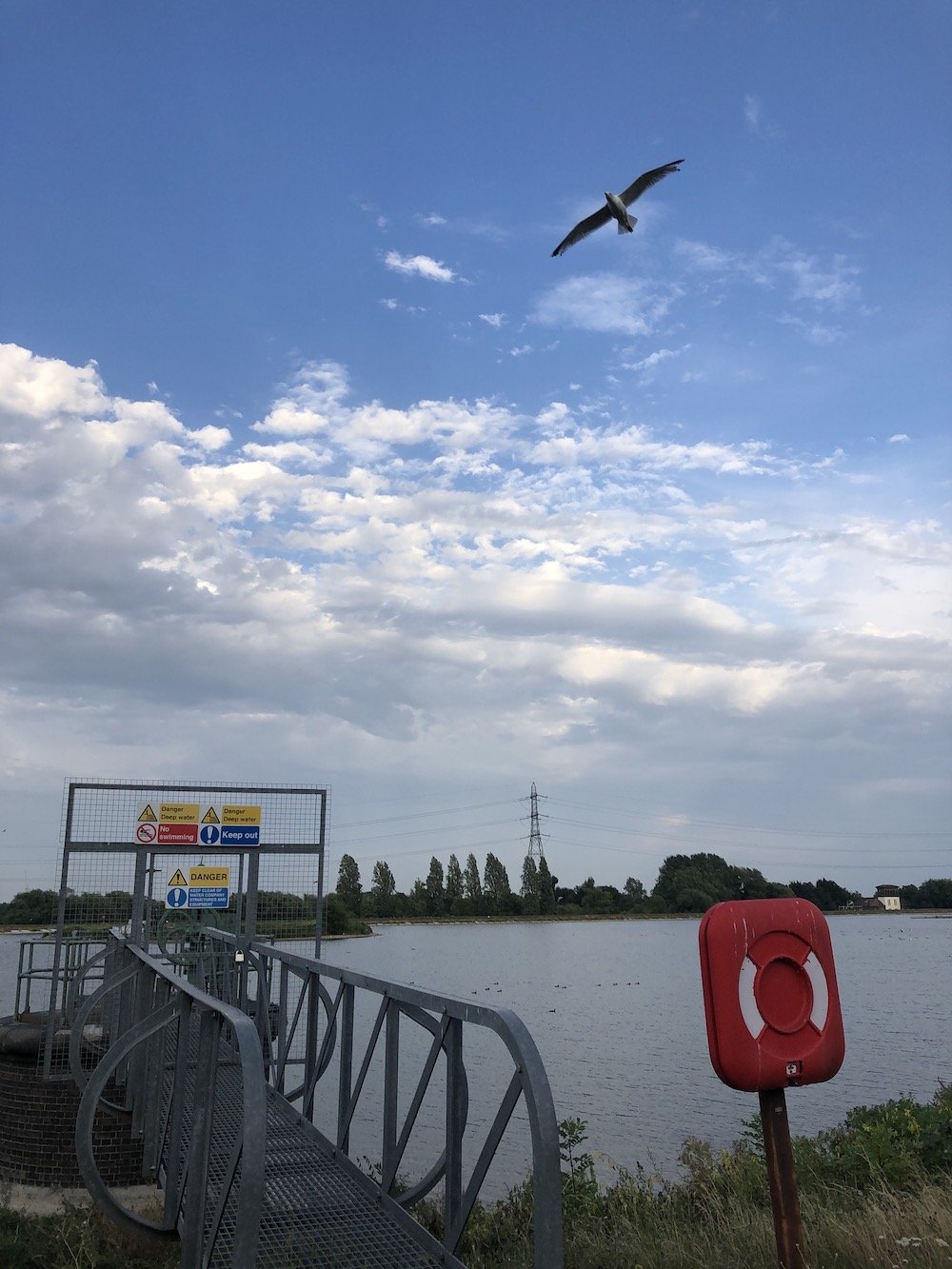
Along the way I come across a male Reed Bunting calling from the top of a reed stem. I forget my previous commitment to fraternite and decide to make it today’s star. It’s been runner up many times over the summer (more than I’ve mentioned here), but pipped at the post by the last minute appearance of a hobby, a curlew or — insult of insults — the non-appearance of a lesser witethroat.
It doesn’t sing today. No series of creaky whistles with a dropped tin can flourish at the end. Its black hood and bib is also showing the early signs of autumn moult. For a few short months it has been the most well dressed man in the reeds, but soon the crisp pattern will have faded — particularly at the seams — and it will be just another little brown job. I do recall, as a child, we’d very occasionally, during the coldest spells, get one feeding in the garden, longer tailed and shorter legged than the other birds, as if someone had injected 10% blobfish genes into a sparrow.
It keeps calling and as I continue along the path, drawing gradually closer, the four family members it has been warning fly across to West Warwick, with papa taking up the rear. At least the third family I’ve seen this year, so quite a good breeding season.
From the top corner of East Warwick I look across to West Warick and get a glimpse of a couple of smallish ducks with fairly pointy tails upending in the shallows. Could they be a couple of garganey? It’s just about getting to the time when they would start passing through. Too distant and semi-obscured from here I turn tails and power-walk towards the tunnel beneath the railway — the final showdown of the season is afoot.
Parakeets fly overhead as I leave the tunnel, funneling over to the canal, from where they will make their way south to the communal roost. It is getting late, and under the heavy, proto-storm clouds it feels later. But not a violent, apocalyptic, end of days darkness — the sun glows warmly through the thinning portions, and makes a frieze of the few veils of drizzle dripping over distant boroughs. It is the romantic gloaming of romantic poetry, and on its warm breeze brings a sense of satisfaction and wholeness.
I arrive at the south of the reservoir and the ducks reveal themselves to be gadwall, of which there are in fact five (which would be a truly remarkable number, were they garaganey). Never mind — the thrill of the chase was, as it always is, a tonic. A few juvenile moorhens potter about too, as well as two linnets, two little grebes and two egyptian geese lining up fro their place in Walthamstow’s ark. I hear a familiar grating call and 2 sand martins whizz on board. Up above I hear a screech and there — not wanting to be left out of the grand finale — is a lone swift, reminding me that it made this town, this town would be nothing without it, and if I think this town has a future without it… fugeddaboutit.
The sky by now is an enchanting and deranged explosion of inkblot washes on wet paper, and the foreground settles into premature twilght. As if on cue, a capoeira group strikes up in nearby Markfield Park and its dirgey drums and gourds just about complement the dialling down day and its ever retreating chorus of birds. I disturb woodpigeons trying to roost from every bush I pass and properly silhouetted canada geese fly in low to skid to a stop close to their island base. The same dive-bombing herring gull puts in a repeat performance, but over the course of the hour has transformed from white knight to silhouetted watchman. The drums mingle with its calls and, again, I feel the happy pang of the last evening of a perfect holiday. But time to go home.
These birds are boring anyway.
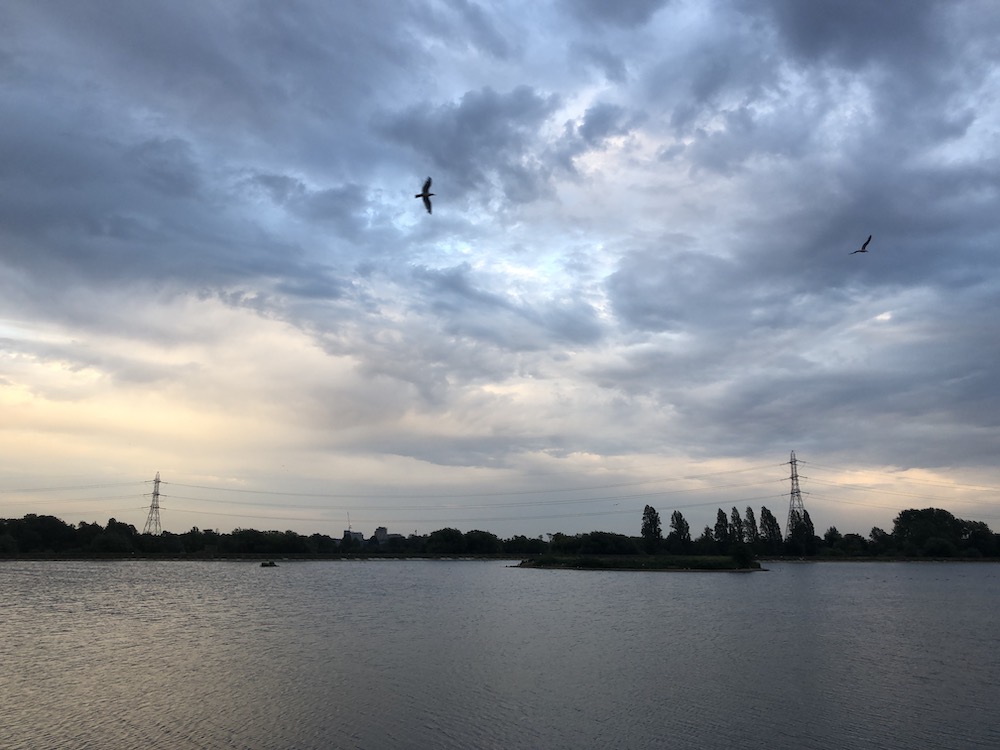
. . .
P.S. Of course the blog will continue — it’s mostly been an absolute pleasure writing and “researching” it — but there’s no way I can sustain it being daily. Over the past two months it’s added an additional self-imposed restriction to the already locked-down world in which I live. With one notable exception, I’ve cycled far less, I’ve seen less of friends than I would have liked to now that restrictions are lifted a little, and I’ve not really contemplated the possibilities for heading out of the city to do other things, such as a hike on the south downs. And spending 2-3 hours daily writing has alos meant my enthusiasm fro cooking, DIY, playing music, reading and other domestic activities has taken a back seat.
Time to write less and do more.
Speaking of which, I might go and see what’s on the reservoirs today…
P.P.S Have run some photos by an expert and today’s bird is a yellow-legged gull after all. So, on the one hand, Yay - that’s a full 61 birds (if a little misaligned), but on the other, I clearly still don’t know how to identify one with certainty. So back to the drawing board there.
🦅 First boring bird
Related boring birds: Greylag goose, Coot, Tufted duck, Mute swan, Great crested grebe, Common sandpiper, Little egret, Yellow-legged gull, Dunnock, Robin, Common tern, Tufted duck, Moorhen, Chiffchaff, Blue tit, Long-tailed tit, Great tit, Chaffinch, Blackcap, Black-headed gull, Herring gull, Ring-necked parakeet, Gadwall, Linnet, Little grebe, Egyptian goose, Sand martin, Swift, Woodpigeon, Canada goose
🦚 All boring birds
Yaffle